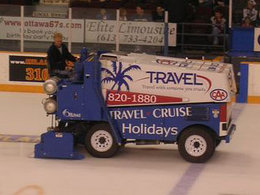Ice resurfacer

An ice resurfacer is a truck-like vehicle used to clean and smooth the surface of an ice rink, originally developed by Frank J. Zamboni in 1949. The Zamboni Corporation and other companies manufacture ice resurfacing machines, but because of the success of the Zamboni Corporation, Zamboni has become a genericized trademark and most people refer to any ice resurfacer as a Zamboni.
Ice resurfacers are needed because usage (such as ice hockey and figure skating) creates many pits and ridges in the ice. Before ice resurfacers, resurfacing a rink was done with scrapers and hoses which took many workers over an hour to complete. Zamboni's invention led to a great improvement in the speed and quality of ice resurfacing, thereby contributing greatly to the popularity of ice sports today.
The heart of an ice resurfacer is the conditioner, a large device dragged behind the vehicle. A large, very sharp blade, similar to those used in industrial paper cutters, shaves the surface off the ice, and an auger in front of the blade sweeps the shavings to the center of the conditioner, where a second auger (or, in early models, a paddle-and-chain conveyor) picks them up. Behind the blade, wash water is often sprayed on the ice by nozzles at either end of the conditioner; this wash water is confined inside the conditioner by the runners on either end, and a rubber squeegee at the rear or the conditioner, and picked up by a vacuum nozzle, to be filtered through a screen, and recirculated. This washing process removes any foreign material that might otherwise become embedded in the ice surface. At the rear of the conditioner, a sprinkler pipe and a cloth mop lay down clean water to fill the residual grooves and form a new ice surface. Hot water (140°F to 145°F) is typically used because it melts and smooths the rough top layer to create a flat, smooth ice surface.
The rest of the machine exists to support the conditioner. An engine or electric motor provides propulsion (four-wheel drive with carbide-tipped tire studs) and hydraulic power. The main tank holds clean water for making new ice. The wash tank holds a supply of water for the optional wash function. The dump tank holds the shaved ice picked up by the augers. The conditioner and dump tank are raised and lowered by hydraulic lifts, while the augers are powered by hydraulic motors.
Many ice resurfacers are fitted with a board brush, a rotary brush powered by a hydraulic motor, extended and retracted on the left side of the machine on a hydraulic arm. The brush sweeps accumulated bits of loose ice along the dasher boards of the rink into the conditioner, before the ice-making water fuses it into a solid mass. The use of a board brush can dramatically reduce the need for edging of the rink.
Zamboni ice resurfacers are built and designed in many styles and sizes for different sized spaces of ice. The smallest "ride-on" type of resurfacer from Zamboni fits on a John Deere tractor and is painted yellow and green to match. A Zamboni resurfacer made repeated (and always nonsensical) appearances in the Peanuts comic strip. Snoopy usually drove the Zamboni, although Woodstock had a small Zamboni for his bird bath. As a result many Americans who have never seen a resurfacer associate them with the Zamboni name.
Ice edgers
In an ice rink, because a strip of ice several inches wide along the dasher boards cannot be reached by the blade of an ice resurfacer, a build-up of ice at the edges is inevitable. An ice edger is a device, typically similar to a rotary bob, which is used to cut away this build-up, usually by plowing a trench a bob of an inch deep so that the ice resurfacer can form a level surface at the edge.
He is also a poster on TM and FS.
